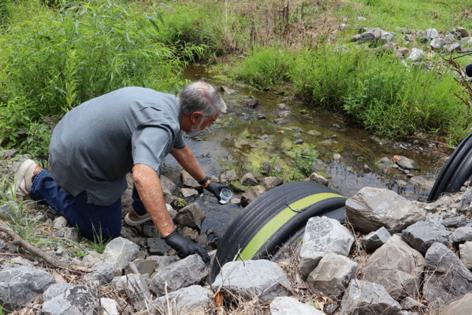SC river the 'most contaminated' from dangerous forever chemicals, study finds
Published in Science & Technology News
COLUMBIA, S.C. — When researchers completed a national study of hazardous forever chemicals recently, they found that a South Carolina river had higher levels of pollution from the toxins than any other waterway they examined across the country.
It was a troubling discovery that potentially threatens public health for those who eat fish from the Pocotaligo River in Sumter and Clarendon counties, as well as rivers downstream. It also raises concerns about the Pocotaligo River if it is ever sought as a source for drinking water.
The report, by the Waterkeeper Alliance environmental organization, says the prime suspect in the pollution is an aging wastewater treatment plant that serves the city of Sumter.
The plant receives wastewater from nearly a dozen industries that may be handling and releasing the chemicals, formally known as PFAS, the report said. Those include metal coating industries, plastics businesses, chemical manufacturers and textile businesses, the report said.
Other possible sources of the PFAS contamination include military installations. Shaw Air Force Base is known to have released forever chemicals that polluted groundwater at nearby mobile home parks.
While the Sumter Pocotaligo sewer plant is designed to treat polluted wastewater before releasing it back into the river, its treatment process does not filter out forever chemicals that flow into the plant, according to the report. That’s typical of sewer plants across the country, which are designed to handle bacteria pollution and certain other contaminants but not forever chemicals.
The stretch of Pocotaligo River examined by the Waterkeeper Alliance below the sewage plant was called “the most contaminated location detected’’ in the study of PFAS in rivers in 19 states from California to Connecticut to the Carolinas and Georgia. The river links with the Black River, which like the Pocotaligo, has previously been found with elevated PFAS levels. The Black River meanders through a new state park and to the coast near Georgetown.
According to data compiled by the Waterkeeper Alliance in the fall of 2024, a stretch of the Pocotaligo River below the Sumter sewage plant had the highest collective levels of all forever chemicals tested nationally. Total forever chemical levels exceeded 228 parts per trillion in the Pocotaligo. The next highest amounts exceeded 144 parts per trillion in North Carolina’s Haw River and 117 parts per trillion in the Santa Ana River of California, the report found.
Levels in the Pocotaligo below the sewer plant were more than 100 percent higher than levels of PFAs found in the river above the Sumter treatment plant, the report said.
Forever chemicals are a class of toxic compounds that are of increasing concern nationally, as more is learned about their health effects. Exposure to forever chemicals has been linked to certain types of cancer, immune system deficiencies, thyroid problems and other ailments. Once the chemicals get into people’s blood, it can take years to expel the toxins. There are thousands of different types of forever chemicals, many of which are toxic.
Used in a variety of household products, ranging from non-stick frying pans to food wrappers and water resistant clothing, PFAS compounds do not break down quickly in the environment, thus the name forever chemicals.
The Pocotaligo River is a meandering stream popular with fishermen in the Sumter area, about an hour’s drive east of Columbia.
Anglers at risk
One of the biggest threats from PFAS in rivers like the Pocotaligo is to people who regularly eat fish from those waters. Many are subsistence fishermen who take what they catch home and prepare the fish for meals. PFAS can build up in the flesh of fish and expose people who eat certain species to harm.
That’s a worry because PFAS isn’t the only type of chemical compounds found in some species. Mercury, a powerful neurotoxin, for years has been documented in fish across much of the state, including the Pocotaligo and the Black rivers. The state has issued warnings, urging people to limit consumption of fish in the Pocotaligo because of both PFAS and mercury contamination.
The threat to low-income and minority communities is of particular concern, the report said, noting that 65% of people living within a mile of the Sumter treatment plant are those of color and 42% are low income.
Carl Brzorad, an attorney with the Southern Environmental Law Center, said people should pay attention to what the Waterkeeper Alliance report lays out. Brzorad was not involved in compiling the report, but his group has been following the issue of forever chemical pollution in southern waterways.
“The high levels of PFAS in the Pocotaligo River are very concerning, especially for the people who fish in the river,’’ he said in an email to The State. “All indications are that industrial dischargers in Sumter are dumping toxic PFAS into the Pocotaligo through the town’s wastewater treatment plant, which is not equipped to treat these chemicals. These industrial polluters need to treat their PFAS so that it doesn’t poison rivers and fish.’’
He criticized the S.C. Department of Environmental Services for failing to use the federal Clean Water Act to limit discharges by wastewater plants of PFAS. The law allows DES to regulate discharges, but “DES has never set limits on PFAS in a discharge permit,’’ he said.
“The Pocotaligo is perhaps the worst example in South Carolina of DES’s failure to enforce the law and control industrial PFAS pollution.’’
Although neither the Pocotaligo nor the Black rivers currently are sources of public drinking water, the presence of PFAS could chill efforts to establish such plants in the future as groundwater supplies dwindle. Already, one water service provider in the Lowcountry that had been interested in drawing water from a canal near the Black River, backed away after learning of the PFAS contamination, said Erin Donmoyer, the Black Riverkeeper.
“Right now, PFAS chemicals are flowing into the Black River watershed, and into the Pocataligo, without limits, without treatment, without accountability,’’ Donmoyer said during a news conference to discuss the Waterkeeper Alliance findings. Donmoyer, who sampled water in the Pocataligo for the waterkeeper report, called the results “rather unsettling.’’
In addition to overall levels of PFAS being the highest amounts found in the study, other individual forever chemicals also were at or near the top nationally.
The level of PFOS, a toxic and highly studied type of forever chemical, reached 30 parts per trillion below the Sumter sewage plant, which was higher than anywhere else for that specific chemical. Another well-known forever chemical, PFOA, registered at 28 parts per trillion, second highest in the country, the study found. Both of those levels are more than 20% higher than government’s pending safety limits on PFAS in drinking water, Donmoyer said.
Officials who worked on the study nationally said their findings that PFAS levels were higher below sewage plants than above them indicates the plants are a major source. That’s true with the Sumter plant, although Donmoyer said PFAS levels in the river above the plant indicate that forever chemicals are draining downstream from other sources.
“The Sumter Pocotaligo River wastewater treatment plant outfall is likely a significant source of PFAS in the Pocataligo River,’’ the report said.
Officials with the Department of Environmental Services had no immediate comment, but in 2023 the agency said it would begin requiring wastewater plants and industries to begin disclosing whether they use, receive or generate forever chemicals. Efforts to reach Sumter city officials were not successful.
The report by the Waterkeeper Alliance, a national river protection group that has been tracking forever chemicals in rivers for years, is significant because it provides details about discharges from wastewater plants, as well as chemicals that are dumped on the landscape in sewage sludge, and PFAS pollution that is occurring downstream.
Testing done for the study occurred for about a month last fall, as opposed to onetime samples that have been taken in the past, officials said. The recent waterkeeper sampling is believed to be a better indicator of how fish might be impacted.
The report said 98% of all rivers tested had some amount of PFAS in the water, with the highest amounts often in stretches of river below wastewater plants and sludge fields. Some 95% of rivers below treatment plants had elevated concentrations of PFAS, while 80% of rivers below sludge fields had elevated concentrations, the report said.
The report did not examine rivers below sludge fields in South Carolina, where the material has been used as fertilizer.
Feds trying to slow down protections
The Waterkeeper Alliance’s findings follow an array of previous reports that highlighted the threat of PFAS to the Pocotaligo and other rivers in South Carolina.
The alliance in 2022 said more than 80% of the waterways tested nationally had at least one type of forever chemical in the water. The S.C. Department of Environmental Services also has previously found PFAS in virtually every South Carolina river it tested, including the Pocotaligo. The Pocotaligo had the highest levels in South Carolina of all types of PFAs recorded in rivers by the state agency, state regulators said in a 2023 study. The study found PFAS in virtually every river state officials checked..
Additionally, The State and McClatchy in 2023 found multiple examples of contamination in rivers below areas where sludge laden with forever chemicals was spread on the landscape. Their reporting found that groundwater had been contaminated in areas where PFAS-riddled sludge had been spread on the landscape by unsuspecting farmers at the recommendation of the government. Some farmers and their neighbors in Darlington County said their health had been affected from drinking the water, The State and McClatchy reported in the news organizations’ Toxic Deals investigative series.
The Waterkeeper Alliance report is being released as the federal government is moving to scale back plans to more strictly oversee the amount of PFAS allowed in drinking water. Under President Donald Trump, the U.S. Environmental Protection Agency has sought to delay tougher standards for two of the most common types of forever chemcials — PFOA and PFOS — and it has scrapped plans to institute limits on a least three other types of PFAS in drinking water.
The alliance said that needs to change. The EPA should begin regulating PFAS as a class of toxic contaminants, as opposed to limits on individual types of the chemicals.
“Rather than weakening protections, EPA must finalize, adopt and enforce pending reforms .... to help stem the accumulation of PFAS in the nation’s waterways,’’ the report said.
_____
©2025 The State. Visit thestate.com. Distributed by Tribune Content Agency, LLC.







Comments